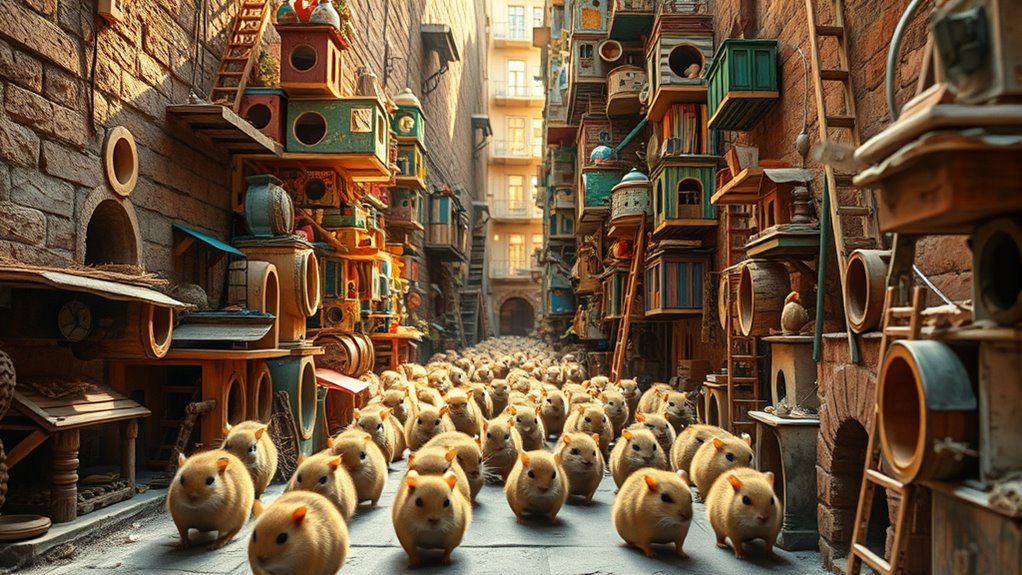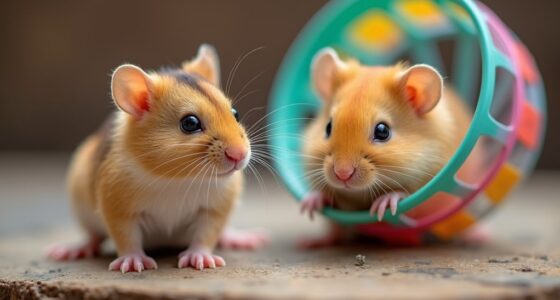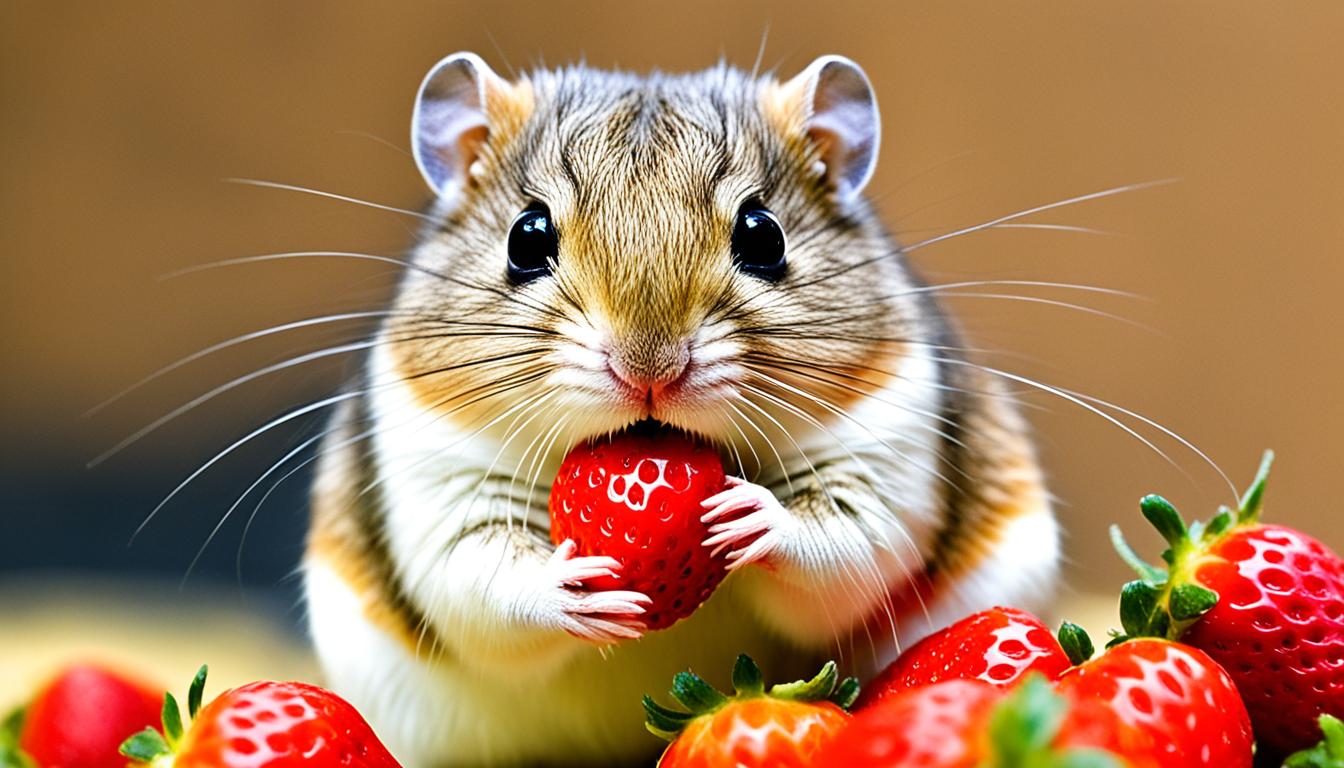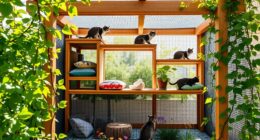As your gerbil population grows quickly, it’s essential to get creative with their housing. Expand and deepen burrow systems, add tunnels to increase complexity, and upgrade to larger enclosures to prevent overcrowding. Incorporate natural materials like tunnels, hideouts, and digging areas to promote natural behaviors and reduce stress. Smarter designs keep your gerbils active and happy. If you’re curious about more ideas, you’ll discover helpful tips by exploring further.
Key Takeaways
- Expand enclosure size and depth to accommodate increased population and prevent overcrowding.
- Incorporate complex tunnel systems and multiple chambers to mimic natural burrows and promote activity.
- Use durable, easy-to-clean materials like glass or plastic to ensure hygiene and safety for growing groups.
- Introduce additional hiding spots and digging areas to reduce stress and territorial disputes among gerbils.
- Regularly assess and upgrade habitat features to maintain stimulating, comfortable environments for larger populations.
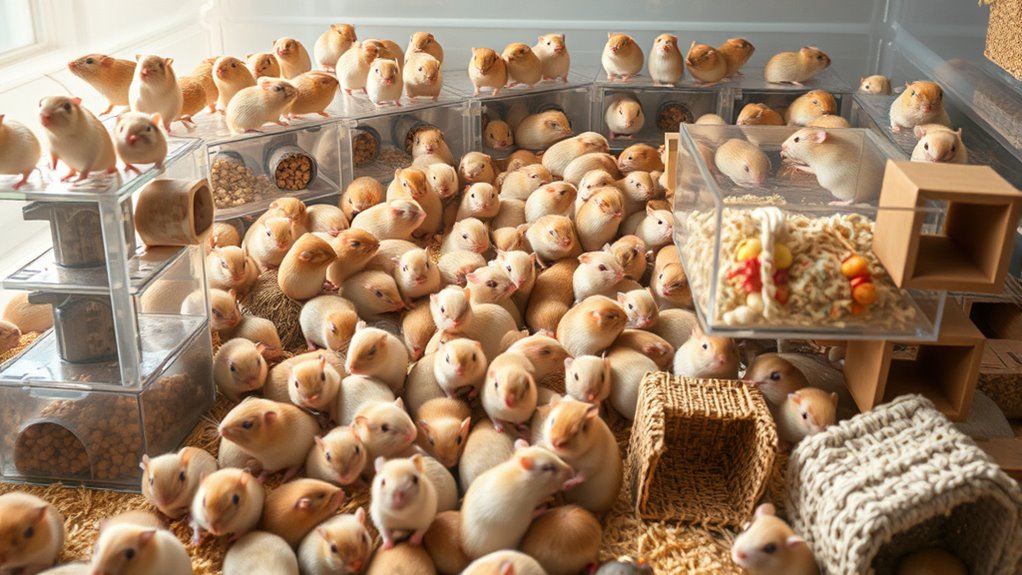
Gerbils need a comfortable and secure home to thrive, and choosing the right housing is essential for their health and happiness. When managing a growing population of these energetic creatures, the focus often shifts to creating environments that mimic their natural habitat while accommodating their increasing numbers. The key to successful gerbil housing lies in thoughtful burrow design and selecting appropriate enclosure materials.
Your burrow design should promote natural behaviors like digging, foraging, and exploring. Think of it as building a miniature underground world that encourages activity and reduces stress. Incorporate tunnels, chambers, and hideouts to provide variety and security. You might use plastic tubing, ceramic hideouts, or even custom-built cardboard tunnels to create a layered, complex network. This not only makes the environment engaging but also helps prevent boredom and territorial disputes, which can escalate as populations grow. The design should include multiple entry and exit points, ensuring each gerbil has safe escape routes and access to different parts of the enclosure. Digging areas filled with soft, loose substrate allow them to exhibit their natural burrowing instincts, which is essential for their mental and physical well-being. Additionally, providing appropriate enclosure materials that are safe, durable, and easy to clean contributes significantly to a healthy habitat.
Equally important are the enclosure materials you choose. The habitat’s walls, floors, and accessories must be safe, durable, and easy to clean. Avoid materials that can injure your gerbils or harbor bacteria. Glass tanks are popular because they’re sturdy, transparent, and easy to disinfect, but ensure they have ample ventilation to prevent humidity buildup. Plastic cages with secure, escape-proof lids can also work well, especially if they include a variety of levels and platforms. When selecting substrate materials, opt for safe, dust-free bedding like aspen shavings or paper-based products that promote digging and comfort. These materials support burrow construction and provide comfortable nesting spots.
As your gerbil population expands, it’s important to regularly assess and upgrade their housing. Deepening burrow systems, adding new tunnels, or increasing enclosure size ensures each gerbil has enough space to express natural behaviors. Using the right enclosure materials and designing functional burrows helps prevent overcrowding and aggressive behaviors, ultimately promoting a healthier, more stimulating environment. Remember, a well-designed habitat tailored to their instincts and needs keeps your gerbils happy, active, and content as their numbers grow.
Frequently Asked Questions
How Do Gerbils Reproduce so Rapidly?
You might wonder how gerbils reproduce so rapidly. Their reproductive habits include short breeding cycles, with females capable of becoming pregnant again just hours after giving birth. They have multiple litters each year, often with several pups per litter. This quick turnaround, combined with their ability to breed frequently, explains their population explosion. Their efficient breeding habits make them prolific breeders, allowing their numbers to grow swiftly.
Are There Natural Predators Controlling Gerbil Populations?
You might wonder if natural predators help control gerbil populations. While some animals like owls and foxes prey on gerbils, predation control is often insufficient to keep their numbers in check. Gerbils have adapted to avoid predators and reproduce quickly, which means their populations can explode despite predation. So, relying solely on natural predators isn’t enough to manage their rapid growth effectively.
Can Gerbils Survive in Urban Environments?
Imagine a tiny explorer traversing your city’s labyrinth of urban tunnels. Gerbils can survive in urban environments, adapting well to underground spaces like tunnels. They’re resilient, often thriving despite noise disturbances and human activity. Their ability to find shelter amid city crevices shows their adaptability. So, yes, gerbils can make themselves at home in urban settings, turning cityscapes into their bustling, underground habitats.
What Are the Ecological Impacts of Gerbil Overpopulation?
You might not realize it, but gerbil overpopulation can cause serious ecological impacts. When their numbers grow unchecked, they become invasive species, disrupting local ecosystems. This leads to ecosystem disruption as they compete with native species for resources, damage habitats, and spread diseases. Your awareness of these impacts helps highlight the importance of managing gerbil populations to protect biodiversity and maintain a healthy ecological balance.
How Do Climate Changes Affect Gerbil Populations?
You might notice that climate variability markedly impacts gerbil populations by causing habitat shifts. As temperatures rise or rainfall patterns change, gerbils may find new areas or lose existing habitats, leading to population increases or declines. These habitat shifts can make gerbils more adaptable in some regions, but also threaten their survival in others. Understanding these climate effects helps predict future population trends and manage their ecological impact effectively.
Conclusion
As the gerbil population continues to grow like a wildfire, your creativity is essential in designing new housing solutions. Think of it as building a cozy maze for tiny explorers, where each tunnel and nest offers comfort and safety. By staying innovative and resourceful, you can keep these lively creatures happy while preventing chaos. Just like a skilled gardener tends to a thriving garden, your efforts will help manage the gerbil surge smoothly and successfully.
